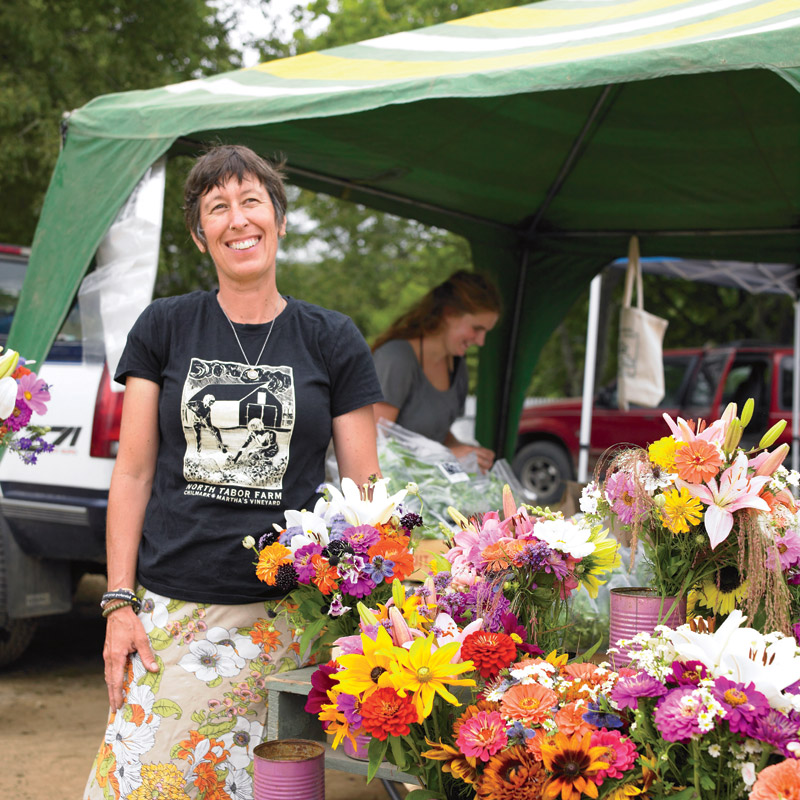Martha’s Vineyard — Gardens, Fish, Markets
Read more: House for Sale: Affordable Martha’s Vineyard On Martha’s Vineyard a garden, a clam rake, and a fishing pole will provide you with a lot of exciting ingredients for your summer meals. But for those without a green thumb, or a way with the rod and reel, fish markets and some 30 farms offer […]

Rebecca Miller of North Tabor Farm sells her shiitake mushrooms, fresh blueberries, flowers, salad greens, and vegetables at the west Tisbury Farmers’ Market, as well as at the farm’s own stand in Chilmark.
Photo Credit : Robbins, HeathRead more:House for Sale: Affordable Martha’s Vineyard
On Martha’s Vineyard a garden, a clam rake, and a fishing pole will provide you with a lot of exciting ingredients for your summer meals. But for those without a green thumb, or a way with the rod and reel, fish markets and some 30 farms offer everything from apples to zucchini, lamb to swordfish, plus wild berries, eggs, milk, and more.
Some people travel to Martha’s Vineyard because they love to eat, and some chefs live here because they love to cook. But great cuisine requires more than great chefs and avid diners; inspiring raw materials and deep cultural roots–traditions of growing, gathering, and preparing–are necessary, too. A remarkable confluence of these culinary factors makes the Vineyard one of the finest places for food in all of New England.
“Coming to the Vineyard, where there’s so much local food–not just fruits and vegetables but also fish and shellfish–helps people reconnect with the natural world,” says Jim Athearn, co-owner of Morning Glory Farm, as he and his wife, Debbie, unload vegetables–cabbages, corn, zucchini, lettuce, beans, peppers, and carrots–flecked with still-moist soil at the farmers’ market in West Tisbury. Rebecca Miller and Matthew Dix of North Tabor Farm arrange cut flowers and bag fresh shiitake mushrooms. Vendors display wares at 20 other stands: potatoes, beets, squash, onions, herbs, chards, honey, jelly, island-spun fibers, handmade candles, herbal salves.
Much of what the island farms offer is available here at the market, but not everything. Islanders can get lamb and chicken at the Allen sheep farm, for instance, plus milk from Mermaid Farm & Dairy and eggs from Morning Glory’s Edgartown store, which also sells soups, salads, baked goods, and prepared meals made with the farm’s own beef, pork, chicken, and veggies. “Local food is about more than flavor and nutrition,” Athearn adds. “It’s also about nourishing local environments and economies.”
At Fiddlehead Farm’s store in North Tisbury, Robert Skydell and Rose Willett market their vegetables, as well as produce from other island farms and an assortment of breads, jams, and pestos. “We offer as many local options as we can and talk to our customers about how to cook what’s in season, to get them excited about the food,” Willett notes. A little farther east, at Whippoorwill Farm, Andrew Woodruff’s customers come by for their weekly Community Supported Agriculture (CSA) shares of assorted produce, where they weigh and bag their selections, chatting and swapping recipes.
But, this being the Vineyard, it’s not just the landlubbers providing good food. Off Menemsha on the last day of fluke season, a handful of draggers–hulking vessels with bits of rust showing through old coats of red, blue, and green paint–chug toward the harbor’s outer channel. At the commercial fishing dock, Chris Stien readies his lobster boat for another day on the water–donning rubber overalls, loading bait barrels, and checking the engine. Gulls circle overhead, drawn by the bait’s aroma.
Stien goes out seven days a week this time of year, checking 80 to 100 of his 450 lobster traps. “Fishing’s a tough life,” he says matter-of-factly. Then he smiles: “But it really is beautiful out here.” And then he’s gone, making for open water and the clang of the buoy bells.
Down island (“down” here means east) at his aquaculture operation in the choppy waters of Katama Bay, Scott Castro checks his oysters, sorting them by size and evaluating their appearance. “For a raw bar,” he explains, “you want oysters that are attractive as well as flavorful.” A few families dig for quahogs in the nearby shallows while an osprey hovers, in search of supper, too. And at The Net Result fish market in Vineyard Haven, Louis Larsen restocks an array of some of the island’s summer ocean offerings: tuna, flounder, halibut, swordfish, striped bass, bluefish, and more. “My family has been fishing on the island for four generations now,” Larsen says, arranging the fillets on ice while customers eye lobsters swimming in the saltwater tanks behind him.
Many Vineyard chefs have perfected the art of blending island ingredients and culinary traditions with contemporary haute-cuisine techniques. “People love ordering a fish dinner that was swimming in the water that morning,” says Doug Hewson, chef and owner of Mediterranean, with a view over Sylvia State Beach to Nantucket Sound beyond. “Especially when the fish is paired with island vegetables.” Hewson prepares rustic, flavorful meals, such as pesto-crusted bluefish with home-grown tomato vinaigrette, and pan-seared almond-coated fluke with a creamy fresh-leek fondue. “Summer fluke is the sweetest,” he says.
Michael Brisson, chef and owner of L’Étoile in downtown Edgartown, offers elegant dining featuring native seafood, lamb, and produce, including dishes such as grilled striped bass with Morning Glory Farm vegetable ratatouille and fava-bean pesto, and a classic lobster etuvee with a serving of more provincial–but no less delicious–clam fritters. “Formal dining should be celebratory as well as appetizing,” Brisson notes.
Sometimes, however, simplest is best: like sampling the raw bar at Coop de Ville while sitting outdoors overlooking Oak Bluffs Harbor, as you sip cold beer and watch the boats and the water going by. Life doesn’t get much better than that.
Read more:Cookbooks from Martha’s Vineyard
RECIPES


